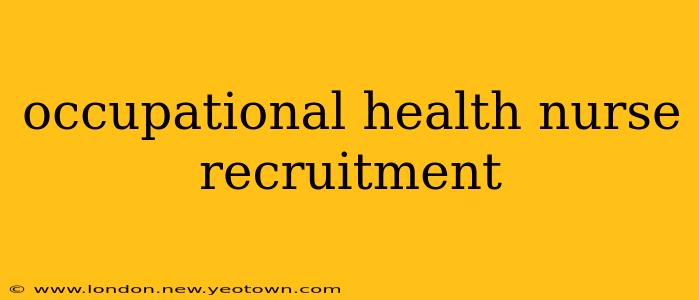The hum of machinery, the scent of fresh paint, the quiet concentration of employees at their desks – these are the sounds and smells of a thriving workplace. But behind the scenes, ensuring the well-being of your workforce is a critical responsibility. That's where the occupational health nurse comes in. Finding the right occupational health nurse is not just about filling a position; it's about investing in the health and productivity of your entire company. This comprehensive guide will walk you through the process of occupational health nurse recruitment, helping you attract, interview, and ultimately hire the perfect candidate to safeguard your employees' well-being.
What Does an Occupational Health Nurse Do?
Before diving into the recruitment process, let's clarify the multifaceted role of an occupational health nurse. They are the guardians of workplace health and safety, performing a range of duties that go far beyond simple first aid. Think of them as the bridge connecting employee health and business productivity. Their responsibilities can include:
- Injury and illness prevention: Implementing safety programs, conducting health assessments, and providing education on health risks.
- First aid and emergency response: Providing immediate medical attention in the event of workplace accidents.
- Health promotion and wellness initiatives: Designing and leading programs aimed at improving employee health and well-being.
- Case management: Supporting employees returning to work after illness or injury, coordinating rehabilitation and helping them successfully reintegrate.
- Compliance: Ensuring the workplace adheres to all relevant health and safety regulations.
- Data analysis and reporting: Tracking health data, identifying trends, and presenting reports to management to support improvements in workplace safety.
How to Recruit an Occupational Health Nurse: A Step-by-Step Guide
The process of recruiting a skilled and compassionate occupational health nurse is strategic and requires careful planning. Here's a breakdown of the key steps:
1. Defining Your Needs and Creating a Job Description:
This is the foundation of your recruitment process. Be specific about the following:
- Essential Skills and Qualifications: This includes relevant certifications (like a registered nursing license and potentially specialized occupational health certifications), experience levels, and specific skills needed for your industry. Are you looking for someone with experience in a specific manufacturing environment, or do you need expertise in a particular area like ergonomics?
- Responsibilities and Duties: A clear description of daily tasks, projects, and reporting structures.
- Company Culture: Highlight your company's values and working environment to attract the right fit.
2. Where to Find Qualified Candidates:
There are multiple avenues to explore:
- Online Job Boards: Sites like Indeed, LinkedIn, and specialized healthcare job boards.
- Recruitment Agencies: Specialized healthcare recruitment agencies can provide access to a wider pool of candidates.
- Professional Networks: Connect with professional organizations for occupational health nurses to reach potential candidates directly.
- Internal Referrals: Encourage your existing employees to refer qualified candidates.
3. Screening and Shortlisting:
Review applications carefully, paying close attention to experience, skills, and qualifications. Narrow down your options to a smaller group for interviews.
4. The Interview Process:
The interview should be structured to assess not only technical skills but also the candidate's personality and fit within your team. Consider these aspects:
- Technical Skills Assessment: Ask detailed questions about their experience in occupational health, safety protocols, and relevant regulations.
- Communication Skills: Assess their ability to communicate effectively with employees at all levels, including management and those with limited health literacy.
- Problem-solving Skills: Present scenarios that require critical thinking and decision-making.
- Compassion and Empathy: Evaluate their ability to connect with employees on a personal level and provide support.
5. Background Checks and References:
Thorough background checks and reference checks are crucial to verify qualifications and ensure candidate suitability.
Frequently Asked Questions (FAQs)
What qualifications are required to become an occupational health nurse?
Requirements vary by location. Generally, a registered nursing license and potentially specialized certifications in occupational health nursing are essential. Experience in a relevant industrial setting is also highly valued.
What salary can I expect to offer an occupational health nurse?
Compensation depends on location, experience, and qualifications. Research industry averages in your area to determine a competitive salary range.
What are the key qualities of a successful occupational health nurse?
Beyond technical skills, successful occupational health nurses are excellent communicators, compassionate, problem-solvers, and possess strong organizational skills. They are also proactive in identifying and mitigating health risks in the workplace.
How can I ensure compliance with all relevant regulations?
Staying up-to-date on all relevant health and safety regulations is crucial. Partnering with a reputable occupational health consultant can provide support and ensure compliance.
In conclusion, recruiting an occupational health nurse is a strategic investment in the well-being of your employees and the success of your business. By following these steps and creating a comprehensive recruitment process, you can find a highly skilled and compassionate professional to champion the health and safety of your workforce. Remember, the right occupational health nurse is a valuable asset who can significantly contribute to a safer, healthier, and more productive workplace.

